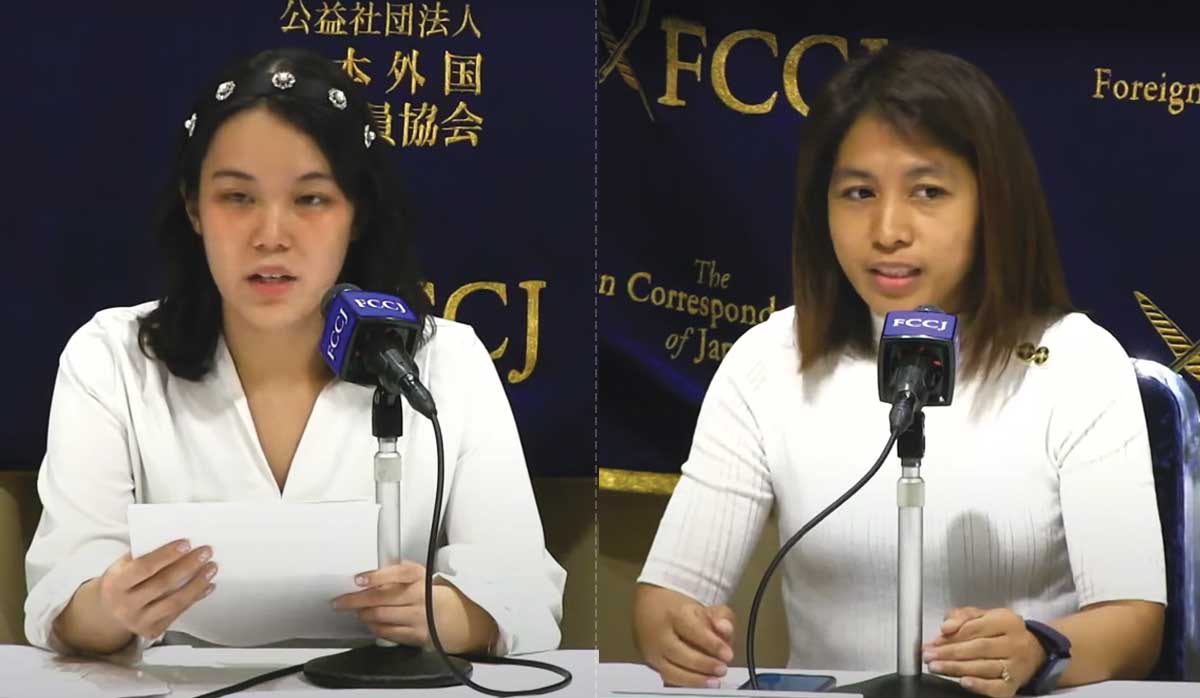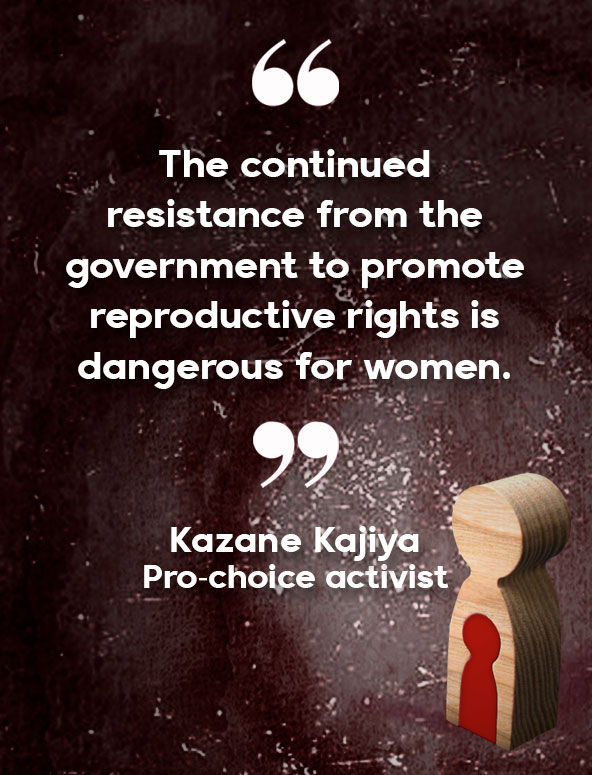Paternal views of women have long excused and helped foster gender discrimination in Japan. But when 25-year-old Kazane Kajiya realized that Japanese laws included one that forces women to get permission from their husbands or male partners to get an abortion, she decided that it was about time for things to change.
Under the term “induced abortion” in its Maternal Health Act, Japan permits the termination of pregnancy during the period when the unborn child cannot survive outside the mother’s body (the first 12 weeks). It also stipulates obtaining consent from the relevant person and the spouse. In cases of rape, consent is not necessary if the spouse is unknown or is no longer in contact with the woman after the pregnancy.
“The regulation is an affront to the reproductive rights of Japanese women,” says Kajiya, a freelance translator who now heads the International Safe Abortion Day project. “My activism aims at only one goal: that females in Japan be able to make their own decisions when it comes to their bodies.”
Being a Japanese woman herself, however, Kajiya knows that she and her fellow activists are in for tough challenges ahead. Japan may be the world`s third-largest economy and boasts of a modern democracy and state-of-the-art technology, yet it also suffers from a stubborn gender disparity.
Just this April, the World Economic Forum (WEF) put Japan in the 120th spot out of 156 countries in its annual list that focuses on the gender gap. It trailed far behind other G-7 countries; Italy, which came in sixth among them, was ranked 63rd. WEF also noted that only 9.9 percent of Japan’s lawmakers are female and that just 14.7 percent of the senior roles in its workplaces are filled by women.

In the male-dominated Japanese society, social norms expect women to be compliant and to keep to their traditional gender roles. (Photo for illustrative purposes only.)
A countrywide men’s club
Japan’s social norms expect women to be compliant in a male-dominated society. Its traditional gender roles support more opportunities for men than for women. Japan’s income tax regulations, for example, allow spousal deductions only if the dependent spouse earns JPY 1 million (US$15,000) a year. Because the dependent spouse is usually presumed to be the wife, critics say that the tax benefit discourages women from seeking higher-paying jobs.
All these mean that Kajiya and company are up against Japan’s powerful male-led bureaucracy and medical sector. They also have to contend with a female population in which most members are more or less resigned to their second-class status.
The articulate Kajiya laments as well the lack of support for equal rights from the likes of popular female politician Sanae Takeichi, who recently contested the election for the new leader of Japan’s ruling Liberal Democratic Party, who would then become Japan`s prime minister. Takeichi, 60, who has conservative-leaning former prime minister Shinzo Abe among her backers, has been open about her support for male-only succession in Japan`s Imperial Family and her stance against same-sex marriage.
Kajiya says she is full of frustration over the politician’s pronouncement. “Yet,” she says, “Takeichi`s stance illustrates vividly the role played by women. She is obviously under pressure to follow social norms in a majority male political world for her survival.”
At a press conference in September, Kajiya and her co-head at the Safe Abortion movement, Riza Haslam, spoke of their struggle to change embedded discrimination. Haslam, a Filipina who had an abortion in Japan, where she has been living for years, described how she felt alone and crushed when she decided to go ahead with the surgery.
“The male doctors did not treat me as an independent woman capable of (m)aking decisions about her body,” she said. “There was no discussion about optional treatment nor was I offered aftercare.”
Haslam, who is married to a Briton, eventually started Women Empower Life, an advocacy group disseminating reproductive health-related information such as safe abortion and access to morning-after pills. She and Kajiya met at a safe-abortion event. Both women stressed that the way for their movement to get ahead includes disseminating information on reproduction health, which is not widely available in Japan. Haslam pointed out, “It is only then that women will be able to speak out for better treatment.”

Women’s reproductive rights activists Kazane Kajiya (left) and Riza Haslam (right) are urging the authorities to abolish the provision in Japan’s Maternal Health Act that requires women to obtain permission from their spouses or partners before getting an abortion. (Screenshot from the Foreign Correspondents Club of Japan)
Pushing forward despite pitfalls
Their fledgling campaign is gaining appeal. By September, Kajiya and her supporters were already able to present more than 40,000 signatures, collected on an ongoing change.org campaign to eradicate the law requiring men to consent to abortions. The activists have since submitted their petition to officials at the Ministry of Health and Welfare.
Kajiya, meanwhile, has amassed a following on Twitter from women who are speaking out about their horrifying experiences of terminating pregnancies in Japan.
“One writer told me she was abandoned by her boyfriend when she was pregnant, making it very difficult to get the abortion,” says Kajiya. Others told her about domestic and sexual violence that left them pregnant and desperately seeking an abortion. The activist points out that with the increase in low-income households and more Japanese women opting to remain single, there is a critical need for change in Japan.
“The continued resistance from the government to promote reproductive rights is dangerous for women,” Kajiya says.
According to data from the Ministry of Health and Welfare, there were a total of 156,430 abortions in Japan in 2019, with the majority performed on women in their 20s. The surgical terminations are usually conducted in the first eight weeks of pregnancy and cost around JPY 100,000 (US$875) each; the procedure is not covered by health insurance.
Condoms remain the main contraceptive method in Japan, leaving women dependent on cooperation from their male partners. Access to birth control pills is only by prescription from a gynecologist. And while pro-life movements are barely visible in Japan, where religion does not play an intrusive role in daily life, the stance of the Health Ministry that warns against easy use of abortion drugs is a portentous obstacle to reproductive rights.

Women’s freedom to choose
Just recently, however, the British pharmaceutical company LinePharma won government approval for the use of Japan`s first oral abortion pill as a safe and affordable method to terminate early pregnancies.
Still, women’s rights advocates are not cheering just yet, aware of other hurdles that they have to overcome. For instance, the country’s limited sex education also helps hold down women, says Satoko Nagaoki, assistant professor of gender studies at Keio University and a member of the Safe Abortion movement, which was launched in the 1980s. Nagaoki, who is now working with Kajiya as well, says that Japanese female teenagers are taught about menstruation and female reproduction mainly from the standpoint of pregnancy and childbirth. She notes, “The aim is to teach women that they are best as mothers. This is a key reason for the lack of freedom for women to make choices.”
Last February, the All Japan Women’s Shelter Network submitted a request to the government seeking the elimination of the provision of consent from men for women seeking abortions. In a statement, Shisato Kitanaka, an associate professor at Hiroshima University and head of the group, told officials that there are “countless cases of victims of domestic violence giving birth unwillingly because they could not obtain the consent of their husbands for an abortion.” In fact, recorded cases of domestic violence are increasing in Japan — more than 30,000 in 2020, or double compared to a decade ago.
In March, the Network got its reply from the government: The Ministry of Health and Welfare proposed new guidelines to the law that would allow victims of domestic abuse to have an abortion without spousal consent. The Japan Society of Obstetrics and Gynecology, under pressure from activists and cases of suicide by abused women who could not get an abortion, has also urged similar changes in the law.
But while activists are encouraged by these small steps forward, they remain on guard. In truth, they say that the rapid decrease in fertility rates — down to 1.4 per woman, the lowest in the world — could lead to another blow to the safe-abortion campaign. Says Nagaoki: “As Japan greys, the government focus is to increase children and that could not help our work to expand female reproductive rights.”
Nevertheless, Nagaoki and other activists say that the Safe Abortion fight will go on. ●
Suvendrini Kakuchi is a Sri Lankan journalist based in Japan, with a career that spans almost three decades. She focuses on development issues and Japan-Asia relations.


















